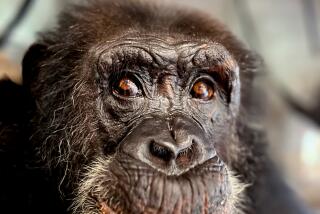To save the chimps, you’ve got to save the people too
- Share via
Jane Goodall’s research has changed the definition of what it means to be a human. When she went to what is now Tanzania in 1960 to study the chimpanzees of Gombe, humans were thought to be the only animals capable of making and using tools. Goodall showed not only that chimps could do that, but also that they had personalities and complex social lives, could hunt for game and even engage in warfare. She is to be in San Francisco today to accept the Leakey Foundation’s prestigious Leakey Prize in human evolutionary science. This week, Goodall, 74, answered questions in a phone interview.
--
Will we still have primates in 50 years?
We shall have lost some of them, but absolutely we will have some.
--
What are the greatest threats now?
Deforestation and human population growth . . . and the bushmeat trade, which does go on all over the world. It’s a very great threat for the great apes: the gorilla, the chimpanzee and the bonobo.
As logging companies open up the forest with roads, hunters can now have access to more inaccessible parts of the forest. They are shooting everything -- elephants, primates, other animals. Then they are carried out on the same roads. It’s totally unsustainable and a major threat in the Congo basin.
--
Is there anything we can do about it?
We’re concentrating on youth education with our Roots & Shoots program, getting them to come and see the chimps. Most Africans don’t get to see these wild animals at all. Once they see and learn about them, they are much more likely to become involved in protecting the environment.
--
Your work has shifted from scientific research to humanitarian efforts. What happened?
In Tanzania, the chimps are isolated in a very tiny patch of forest. I flew over it 13 years ago and realized that, basically, all the trees had gone, that people all around the park are struggling to survive. It became very clear that there was no way to protect the chimps while the people were in this dire circumstance.
We started Take Care, a very holistic program aimed at improving the lives of people in the villages. It emphasizes ways of farming in a very degraded landscape, ways of restoring overused farmland so it can become productive, giving credit to women and scholarships to keep girls in school, and providing information about family planning.
As women’s education and empowerment improves, family size drops. It is the constant growth of population that is underlying so much destruction everywhere.
--
Is it working?
Around the Gombe chimps, many of the villages now have forests going again. In five years, you can get a 30-foot tree growing from a seemingly dead stump.
We’re working with farmers to get them a really good price for their coffee. The villages are so pleased with us that they have agreed with the land management plan to leave 10% to 20% of village land aside for conserving forest or regeneration. The chimps will be able to get out of Gombe and rejoin with other groups.
The size of the family has begun to show signs of getting smaller. In 32 villages, the average number of surviving children was seven. It’s now down to five, but we have to get it down to two. That includes people in the developed world as well. One child in developed society is using so much more resources than a child in an African village.
--
How much time do you spend in Africa now?
I travel 300 days a year. I get to Gombe twice a year, the maximum, a week at a time. Usually, there is a film team tagging along or a group of VIPs, which hinders what I want to do, which is to get out in the forest by myself.
The rest of my time I spend at my sister’s house in Bournemouth, on the south coast of England. That’s where I keep all my stuff and do my writing.
--
Do you miss research?
I think back to those days when I get to Gombe briefly and climb up into the mountains by myself. I think, “My goodness! What have I let myself in for?”
--






